How To Choose The Best Putting Green Turf for Home Golf Greens: Buyer’s Guide

- How To Choose the Best Artificial Grass for Backyard Putting Greens
- What to Look for in the Best Putting Green Turf Products?
- Our Top Pick of the Best Artificial Turf for Putting Greens
- Wrapping up our Buyer’s Guide to the Best Artificial Grass for Home Golf & Putting Greens
If you’re a golf enthusiast, you’d love to be out on the green practicing your short game every day.
But that involves a huge cost in time and money to drive to the course, haul your clubs out, rent a cart, and so on — not to mention the membership fees.
Save on time and gas by installing a putting green right in your own backyard!
With a putting green composed of artificial grass, you can enjoy golfing with your family every day of the week.
If you’re an avid golfer or just considering adding a fun, outdoor activity to your home, read on for how to choose the best putting green turf.
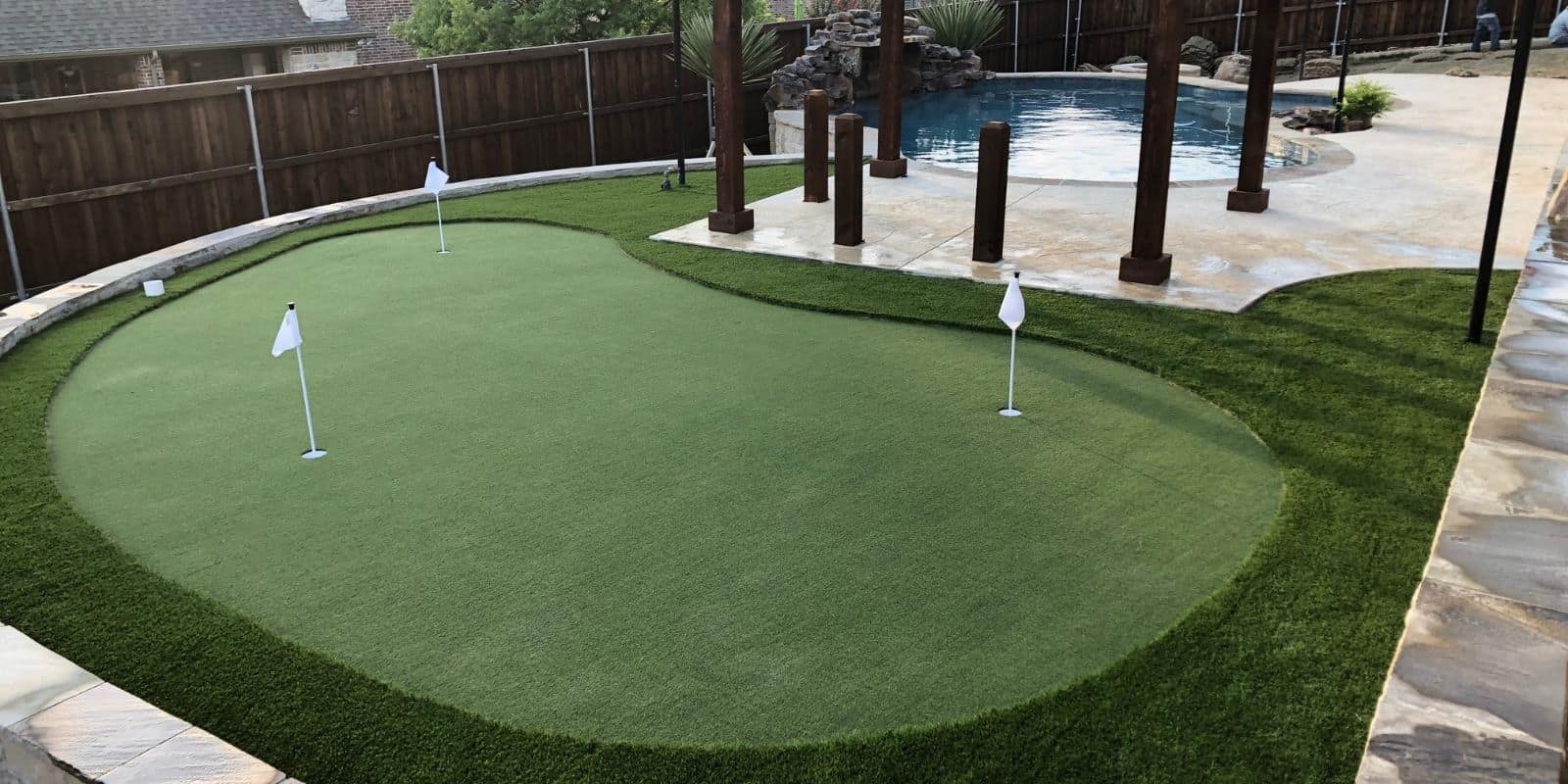
How To Choose the Best Artificial Grass for Backyard Putting Greens
As any groundskeeper will tell you, keeping up a golfing green with natural grass is an insane amount of work.
When hosting professional tournaments, golf courses mow the green several times a day to keep the grass ultra short!
Nobody has time to do that in their backyard, so the popularity of artificial grass for home golf and putting greens has risen substantially.
With artificial turf instead of natural grass, the putting green is the exact right height and beautifully green every day of the year.
No fertilizer or mowing required.
To help you choose the right artificial grass product for your backyard putting green, we’ve put together the following guide to help you evaluate and compare the various features and products on the market.
You should also check out a putting green installation customer review that we recently published on our blog.

1. Perform Research
Any golfer knows the difference between the natural grass in the rough and the natural grass on a putting green, but most people don’t know about all the varieties of artificial grass on the market today.
Just like on a golf course, different species, thicknesses, and heights of artificial grass are suitable for different purposes.
It’s worth your time to conduct a few internet searches and to ask some experts about what products will perform well and which is the best putting green turf.

2. Learn Putting Green Turf Terminology
To know what you are shopping for, spend the time to become acquainted with the specifications and terms used by the artificial turf industry.
Once you understand what each item means, you can hone in on which products would or wouldn’t work for your backyard putting green.
We’ve compiled a basic “dictionary” below to define some of the most common terms you will see as you shop for artificial grass.

Yarn Fibers
Yarn fibers are woven into a backing (more on that later) and stick out one side, forming a lush, grass-like carpet.
Yarn fibers come in a variety of shapes, thicknesses, lengths, and even colors! (We’re looking at you, Smurf Turf.)
Even though there’s a bit of variety to artificial grass products, there’s not much variety in the base materials they’re made of.
There are really only three options:
- Polyethylene
- Polypropylene
- Nylon
Polyethylene is mainly used in the turf’s backing, not the yarn fibers themselves.
Fake grass for putting greens are usually made from polypropylene or nylon, and there are distinct advantages to each.
Nylon is the more durable (and more expensive) of the two.
For the most part, the best putting green turf products will have nylon fibers.
Polypropylene more closely approximates the look and feel of real grass, though it’s more prone to matting and ruts than nylon is.
The silica sand infill absorbs some of the ball’s bounce, just like soil does.

Thatch
Grass doesn’t live forever, so in an organic lawn, layers of dead and dying grass linger beneath the spry, upright blades of the actively growing grass.
Thatch mimics this natural progression, adding tan, curled fibers to mimic the soft padding created by the dead grass.
When you walk in bare feet over synthetic turf with a thatch layer, it feels very close to the cushy feeling of natural grass.
While the presence of a thatch layer is usually a sign of a high-quality turf product, your putting green turf may not need a thatch layer.

Density
The density of a turf product is how many stitches per square meter the material contains.
A more dense product indicates a higher quality.
A dense product has more material to absorb friction from foot traffic than a sparse one and will be more durable over time.

Face weight
This measurement only includes the weight of the yarn and thatch, not the backing.
As with density, a high face weight tells you that there is more material in the turf to take the hits from wear and tear.
High-quality turf products will have a weight of 70 ounces per square yard of material or higher.
Products with low face weights will look and feel threadbare or cheaply made.

Pile height
Similar to carpet, a pile height indicates how tall the synthetic turf fibers stand.
Since you’re looking more to approximate the physics of a real putting green rather than having the swankiest yard on the block, a tall pile height for putting green turf is unnecessary.
It may even be detrimental to your short game.
Putting green turf will have an abnormally short pile height (around half an inch), which would be too short for other applications like a lawn or patio.

Turf Backing
Turf backing is divided into two parts: primary backing (the netting that the grass fibers are woven into) and secondary backing (the “fabric” that’s glued on the back and seals everything together).
Together, these two backings comprise the total back weight.
As with face weight, more is usually better when it comes to turf backing.
For putting green turf, you’ll need a durable turf backing — one with 22oz. or more.

Drainage
The turf’s drainage qualities are determined by the style of backing that’s used.
Many varieties of synthetic turf have a hole-punched backing to allow for rainwater, pet urine, and other liquids to pass through into the soil.
However, with putting green turf, holes punched in the backing would prevent your golf ball from rolling straight.
Putting green turf doesn’t drain the same way other artificial grass does.
However, the square footage of the green is usually small enough that this isn’t a major problem.

Color
With advances in manufacturing, there is now a wide variety of colors of artificial grass.
Artificial grass is designed to look like specific species of grass so they coordinate with neighboring natural lawns.
Since all grass blades aren’t the exact same color, high-quality turf usually includes multiple colors of yarn to create a more realistic look.

Infill Material
To help the turf fibers stand up and hold up to the wear and tear, many synthetic grass products use an infill material.
Just like soil, infill helps keep fibers upright and helps the turf look and feel more realistic.
It weighs the artificial grass down, which prevents wrinkles, warping, and shifting over time.
Infill comes in many varieties, most of which are natural materials. It can be made of sand, cork, walnut shells, ziolite, and more.

Antimicrobial
Pests (mold, fungus, bacteria, and bugs) love to live in the moist shade of grass blades on the lawn.
Sadly, synthetic turf can have the same problem as organic grass in this regard.
However, many turf products come with antimicrobial properties in the backing or infill to help combat problems with buildup of bacteria or mold.
By choosing an antimicrobial product, you’re more likely to avoid issues with unwanted, stale odors coming from your putting green after a rainy day.
We recommend the antimicrobial backing in artificial grass products called “microbe safe.”
This helps prevent the buildup of odors from pet urine (in case your pooch takes a visit to your putting green), as well as germs and bacteria.

UV Protection / UV-Stabilized
Though you might not be out on your golfing green every day, the damaging ultraviolet (UV) rays from the sun will.
The constant exposure to sunlight will eventually cause the turf to crack, discolor, and breakdown.
For this reason, many modern turf varieties include UV stabilizers during the manufacturing process to prolong the life of the product.
Think of it as sunscreen for your putting green.

3. Budget, Costs & Financing Your Home Golf Green
The first question homeowners ask about backyard putting greens is “Is it possible in my yard?” The next one is “How much is it going to cost?”
While installing your own putting green is certainly more expensive than a round of golf, you might be surprised at how affordable it can be.
Most turf installers offer financing options, so you likely won’t have to pay for the project all at once.
It’s worth noting that you will see some returns on this investment.
An artificial grass putting green will save you money on your water bill, as you’ll no longer need to water the grass in that area.
You won’t have to mow or maintain it with fertilizers, pesticides, or herbicides either.
If you decide to sell your home, having a putting green in the backyard will increase the home’s value and help your home stand out from others in the neighborhood.

How Much Does an Artificial Grass Putting Green Cost?
According to Home Advisor, the average cost per square foot of putting green is between $18 and $25.
A small, 100-square-foot green will cost around $2,000, while a large, 500-square-foot one will cost $9,000 or more.
Keep in mind that installing a backyard putting green is a long-term investment.
While the upfront cost may seem steep, you’ll save time and money driving to the golf course.
You will also get more golfing time in since you can play whenever you like!

4. Pros & Cons of Fake Grass for Golf & Putting Greens
The pros far outweigh the cons of using fake grass for a backyard putting green.
| PROS | CONS |
|---|---|
| No mowing or edging | High upfront cost |
| No fertilizers, pesticides, or herbicides | Hotter surface temperature in the summer |
| Lower water bill | |
| No weeds | |
| No insects | |
| Perfectly green grass year-round | |
| Make Friends & Neighbors Jealous! |
Using real grass for a putting green requires constant fertilizing, manicuring, and maintenance.
You might end up spending more time maintaining your green than you do playing golf on it!
You can eliminate that time and hassle by opting for artificial turf on your putting green.

What to Look for in the Best Putting Green Turf Products?
Now that you’re a little more familiar with the terms and benefits of installing an artificial backyard putting green, you’re ready to choose a turf product.
Below, we’ll review the most important characteristics and features to look for in a high-quality putting green turf installation.

1. Can Hand Heavy Foot Traffic
Before selecting a turf product for your putting green, ask yourself who will be using your putting green and how often.
Will they be practicing every day?
Once a week?
Do you have children that will be running around and playing on the turf?
Do you have a dog or dogs?
If yes, how active are they and what size?
These questions and more will help you know how durable the putting green turf needs to be to stand up to the level of usage your home and family will create.
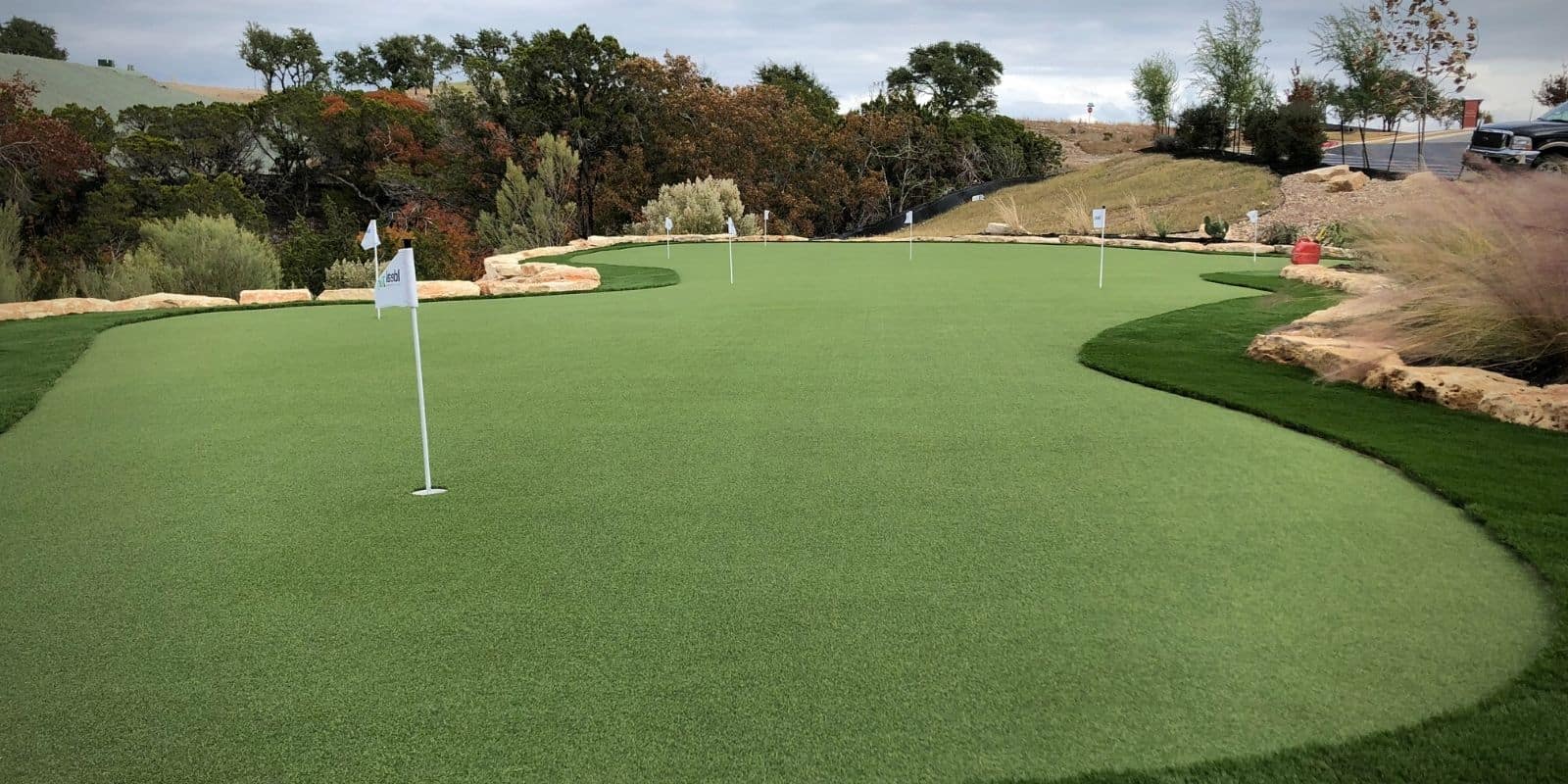
2. Mimics a True Putting Green
The type of artificial grass you choose must be designed to mimic a real putting green, or all your backyard practice will mess with your short game once you get to a competition on a real golf course.
For your backyard putting green turf, choose a short pile height — around half an inch.
Note that products with infill will make the ball roll faster and products without infill will make the ball roll slower.
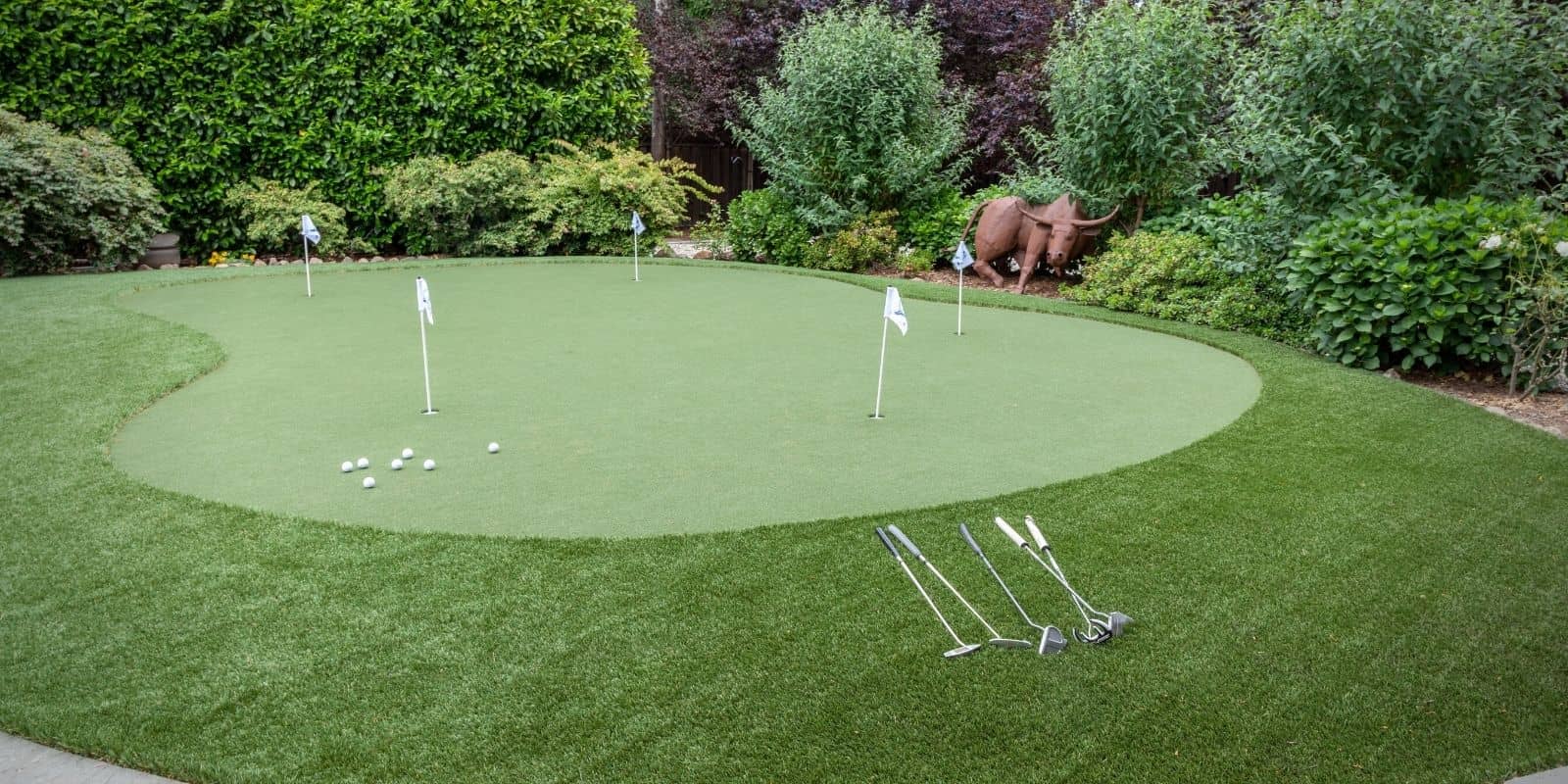
3. Putting Green Layout
Here’s where you can let your creativity shine!
A simple strip of artificial grass with a hole at one end is nice, but with a little help from some professionals, you can reshape your yard to create a golf hole with a little more visual interest.
Use the existing features of your yard such as slopes, berms, trees, and ponds to make the hole more challenging.
With artificial turf, your putting green design is only limited by your imagination.
Remember — even if you’re a beginner in golf now, you won’t be for long when you can practice at home everyday!

4. Maintenance
While maintaining your artificial turf putting green will be worlds easier than if you’d planted real bentgrass, you will have to take care of it to help it look its best.
If you choose a turf product with infill, you may have to replenish it periodically as it can spread over time.
You will also need to remove leaves, twigs, and other debris with a leaf blower or broom.
Since the pile height is so short on putting green turf, fluffing the fibers with a power broom will likely be unnecessary.

5. Trustworthy & Reliable Putting Green Turf Installer
The installation team can make or break your putting green.
While an uneven spot here or there on a lawn won’t be very noticeable, one small divot will completely mess up your putting green.
Choose a reputable and trustworthy artificial grass installation company with a long track record installing putting greens specifically.
Keep in mind that some companies won’t even give you an estimate if the area is to small, so check out reviews from multiple sources that have installed putting greens of similar size and shape to the one you want to get.
Turf installers should answer all your questions and walk you through every step of the installation process.
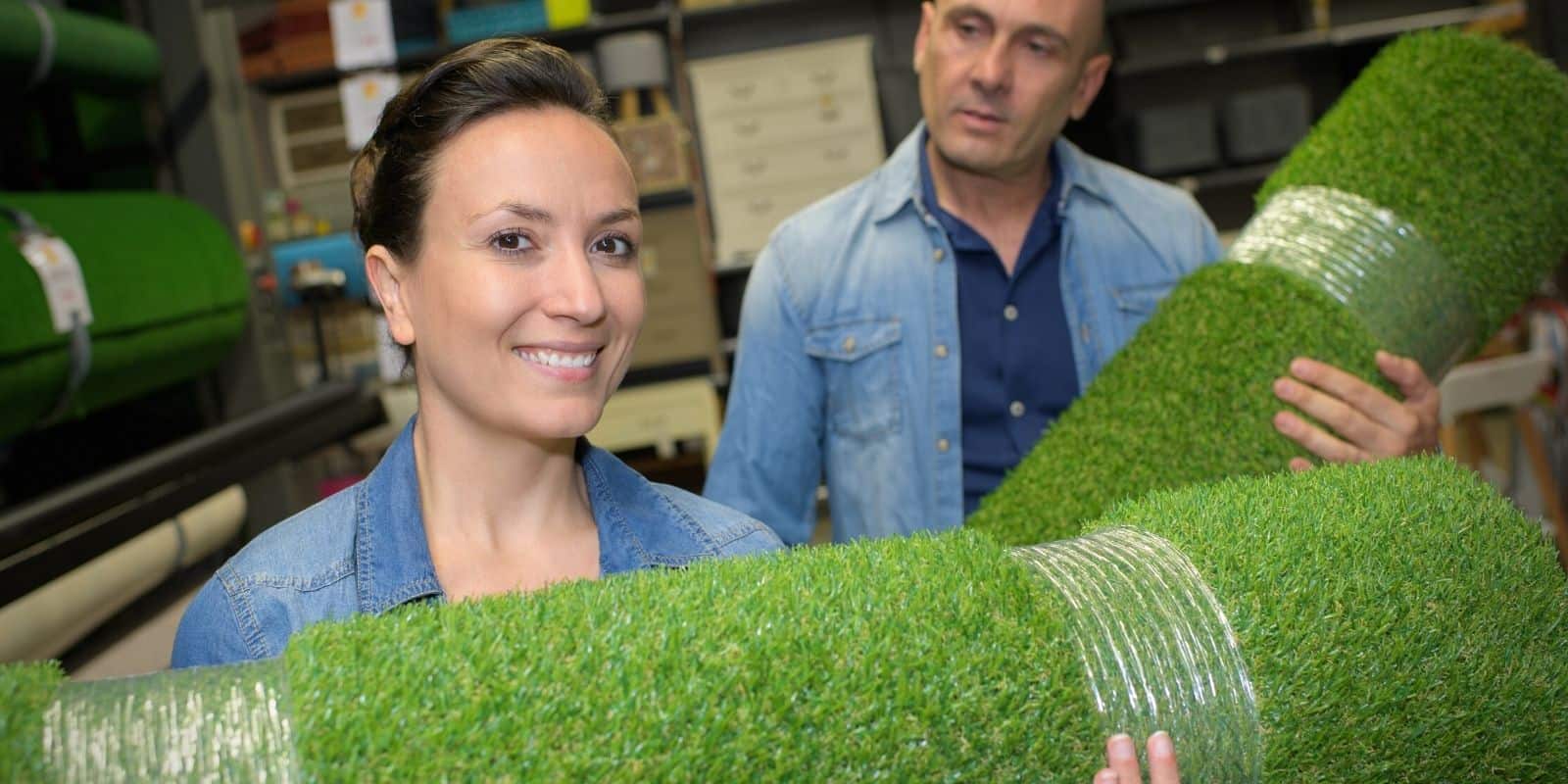
Our Top Pick of the Best Artificial Turf for Putting Greens
There are a number of great putting green turf products on the market, but Ace Putt 56 is our favorite turf product for backyard putting greens.

Ace Putt 56
The Ace Putt 56 is an ideal choice for anyone looking to install a backyard putting green.
The grass blades are made of durable nylon and designed to withstand heavy foot traffic and friction from repeated chipping action.
The short pile height of 0.5 inches and total weight of 72 oz are indicators of its high-quality construction.
It comes with a 20-year manufacturer’s warranty, so you’ll be able to enjoy your putting green for decades to come.
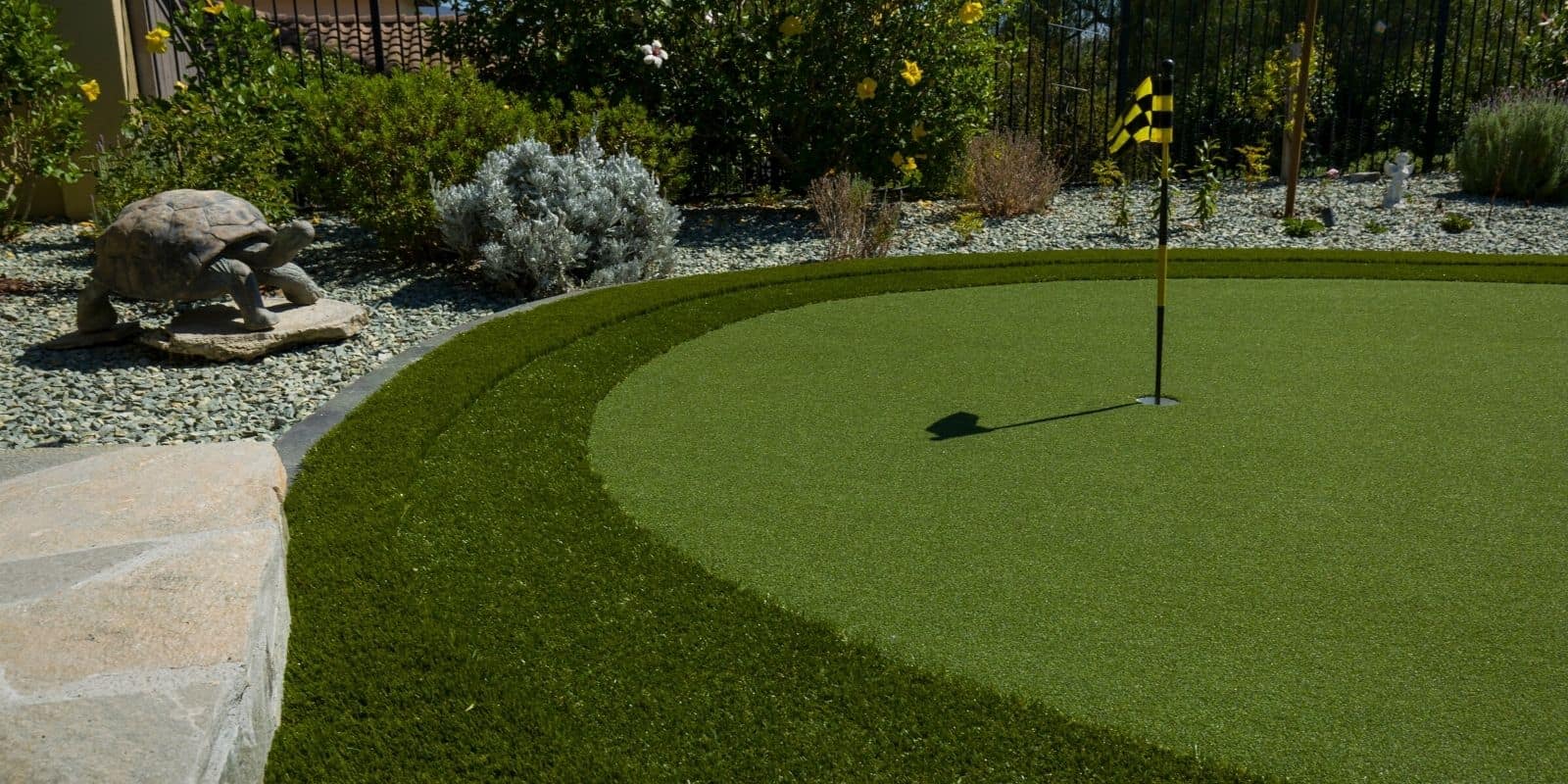
Wrapping up our Buyer’s Guide to the Best Artificial Grass for Home Golf & Putting Greens
Every avid golfer secretly wishes for their own slice of the course to swing a club on every day.
Make your dream a reality with an artificial grass putting green in your backyard!
If you’re ready to install one in your yard or if you’re just curious about if it would be possible in your location, give the putting green installation experts at Ideal Turf a call.
We create putting greens large and small all over Texas and Oklahoma.
Get your FREE artificial grass design & installation estimate by clicking the “GET A QUOTE” button or feel free to give us a call at 800-204-4650.
Recent Posts
- How Synthetic Turf Helps Keep Fleas and Ticks Out of Your Texas and Oklahoma Yard
- Porches, Patios & Personality: Creating Outdoor Spaces Texans Love
- Turn Your Backyard into a Golfer’s Dream: Custom Putting Greens by Ideal Turf
- Why Texas Pet Owners Are Choosing Pet-Friendly Artificial Grass from Ideal Turf
- Why More Texans and Oklahomans Are Turning to Artificial Grass for a Greener Future






